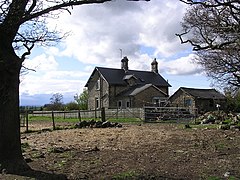
Abbots Bromley is a village and civil parish within the English county of Staffordshire, England. A notably affluent part of the county, Abbots Bromley was rated the best place to live in the Midlands by the Sunday Times in 2013 and again in 2016. The village is a regular entrant and often winner of the Staffordshire Best Kept Village Competition which takes place across the county each year. Originally organised by the Community Council of Staffordshire there is a best-kept village award for a large and small village in each of the county's Districts and Boroughs. Whilst down the years the East Staffordshire district prize has been awarded to Abbots Bromley on a number of occasions the overall county title continues to elude. In August 2017 the village won the double honour of winning both the best kept village and community council trophy award, a double not achieved for many years. This double was repeated again in 2018. In 2019 the competition was taken on by The Community Foundation for Staffordshire and Abbots Bromley won for the third consecutive year. Through the competition Abbots Bromley maintains a healthy rivalry with nearby Yoxall, also a regular winner in the East Staffordshire section.
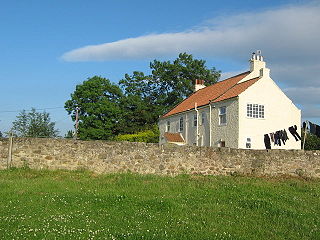
Archdeacon Newton is a hamlet and rural parish of several farms in the borough of Darlington and the ceremonial county of County Durham, in England. The population taken at the 2011 Census was less than 100. Details are maintained in the parish of Walworth. It is associated with an abandoned village site under pasture and farm buildings, and situated a short distance to the north-west of Darlington. The lost settlement was in existence by the early 15th century, and remained inhabited at least until the 1890s. There was a moated manor house at the southern end, part of which remains as the Old Hall, now a barn. At the north end of the site was the chapel, and in the middle were tofts and enclosures, with a ridge and furrow field and a trackway leading to the south-east. The site of the abandoned village is now a scheduled monument and the Old Hall is a listed building.

High Coniscliffe is a parish and village in the borough of Darlington and ceremonial county of County Durham, England. The parish includes Carlbury and Low Coniscliffe. It is part of Heighington and Coniscliffe ward, and is situated approximately 4 miles (6.4 km) west of Darlington. At the 2011 Census the population of this civil parish was 242.

Merrybent is a linear village in the civil parish of Low Coniscliffe and Merrybent in County Durham, in England. It is situated on the A67 road to the west of Darlington, a short distance to the north of the River Tees and the Teesdale Way. At the beginning of the 20th century there were hardly any buildings here, and its main feature at that time was Merrybent Nurseries with its many glasshouses. The nursery was cut through by the A1 road in the 1960s; at this point it runs on the trackbed of the old Merrybent railway. The village is now a settlement of modern housing.
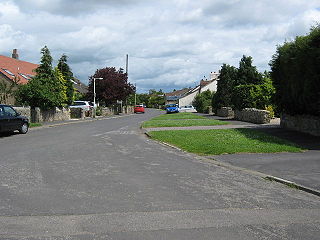
Low Coniscliffe is a village in the civil parish of Low Coniscliffe and Merrybent, in County Durham, England. The population of the civil parish taken at the 2011 Census was 716. It is situated 3 miles (4.8 km) west of Darlington. Its present built-up area is confined in practice between the A1, the A67 and the Tees, but its old boundaries probably extend much further. Its most obvious landmark on the A67 is the Baydale Beck Inn. The village contains a couple of listed buildings and the probable site of a medieval manor house. There was once a gallows in the village. A rare fungus Rhodotus palmatus was found nearby.

Low Walworth is a hamlet in County Durham, England, 1.5 miles (2.4 km) to the north−west of the edge of Darlington. It consists of Low Walworth Hall, Low Walworth Farm and their respective cottages, flats and outbuildings. Several of these buildings are listed, and date from the 17th to the 19th century. Attached to one of the late-18th-century farm buildings is a gin gang, or building from which a horse powered a threshing machine by walking in a circle. The hall has accommodated at least one High Sheriff of Durham.
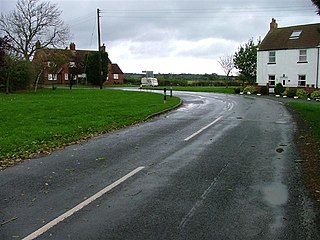
Walworth Gate is a hamlet and crossroads village in the borough of Darlington, in the civil parish of Walworth and the ceremonial county of County Durham, England. It is situated 2 miles (3.2 km) north−west of the edge of Darlington and 0.6 miles (0.97 km) north of Walworth. The settlement is locally notable for New Moor Farm, which is known to Darlington people as a producer of ice cream. The Saxon origin of the name, "Walworth Gate", refers to Welsh−speaking Britons who once lived there.

The Howardian Hills are an Area of Outstanding Natural Beauty located between the Yorkshire Wolds, the North York Moors National Park and the Vale of York, they take their name from the Howard family who still own local lands.
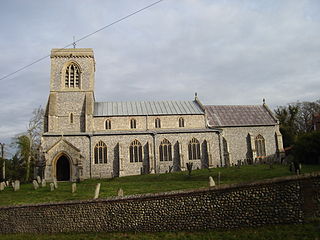
Blickling is a village and civil parish in the Broadland district of Norfolk, England, about 1.5 miles (2.4 km) north-west of Aylsham. According to the 2001 census it had a population of 136 and covers 862 hectares, falling to 113 at the 2011 Census. Since the 17th century the village has been concentrated in two areas, around the church and also at the park gates of Blickling Hall. Most of the village is contained in the Blickling Estate, which has been owned by the National Trust since 1940.

Luddington is a village, part of the civil parish of Luddington with Haldenby, on the Isle of Axholme in North Lincolnshire, England. The population of the civil parish at the 2011 census was 419. It is 6 miles (10 km) north-west from Scunthorpe, 6 miles south-east from Goole and 18 miles (29 km) north-east from Doncaster.

Peckforton is a scattered settlement and civil parish in the unitary authority of Cheshire East and the ceremonial county of Cheshire, England. The settlement is located 6.5 miles (10.5 km) to the north east of Malpas and 7.5 miles (12.1 km) to the west of Nantwich. The civil parish covers 1,754 acres (710 ha), with an estimated total population of 150 in 2006. The area is predominantly agricultural. Nearby villages include Bulkeley to the south, Beeston to the north, Higher Burwardsley to the west, Spurstow to the east and Bunbury to the north east.

Great Hinton is a small village and civil parish about 3 miles (4.8 km) south of Melksham and 3.5 miles (5.6 km) north-east of Trowbridge in Wiltshire, England. The parish includes the hamlets of Bleet and Cold Harbour.

Walworth Castle is an 11th Century castle, situated at Walworth, near Darlington, County Durham, England. It is a Grade 1 listed building. It was completed around 1600, probably by Thomas Holt for Thomas Jenison. It stands on the site of a former manor house or castle built in the 12th century by the Hansard family. The estate passed through the hands of the Ayscoughs and Aylmers besides the Hansards and Jenisons, and became a prisoner-of-war camp during World War II and then a girls' boarding school after the war. It has been a hotel since 1981.

Loversall is a village and civil parish in the Metropolitan Borough of Doncaster in South Yorkshire, England. It has a population of 128, increasing to 156 at the 2011 Census.

Ulnaby is an abandoned village and scheduled ancient monument in the grounds of Ulnaby Hall Farm, near High Coniscliffe, County Durham, England. The toft village was occupied from the late-13th to the 16th century and temporary buildings were erected in the 19th century. Ulnaby Hall farm appears to have been built in the late-16th century, supplanting a high status medieval manorial enclosure associated with the original village. It is thought that the village shrank because of the change from labour-intensive arable farming to pasture, before being abandoned and the site was subsumed into the farm as pasture.
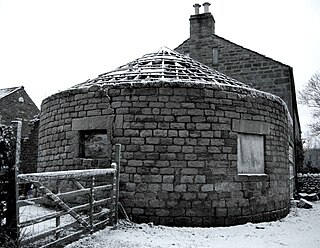
A gin gang, wheelhouse, roundhouse or horse-engine house, is a structure built to enclose a horse engine, usually circular but sometimes square or octagonal, attached to a threshing barn. Most were built in England in the late 18th and early 19th centuries. The threshing barn held a small threshing machine which was connected to the gin gang via wooden gears, drive shafts and drive belt, and was powered by a horse which walked round and round inside the gin gang.

Mendip is a local government district of Somerset in England. The Mendip district covers a largely rural area of 285 square miles (738 km2) ranging from the Mendip Hills through on to the Somerset Levels. It has a population of approximately 110,000. The administrative centre of the district is Shepton Mallet but the largest town is Frome.

Dormington is a village and civil parish in Herefordshire, in the West Midlands of England. Dormington village is at the north of its parish, 5 miles (8 km) east from the centre of the city and county town of Hereford, and 8 miles (13 km) west-northwest from the town of Ledbury. The parish is a significant traditional centre for hop growing.

Ballidon Dale is a steep-sided, dry carboniferous limestone valley near Parwich in the Derbyshire Peak District of England. The ancient hamlet of Ballidon lies at the southern foot of the dale. Ballidon Quarry and Hoe Grange limestone quarries now dominate the west side of the dale.
